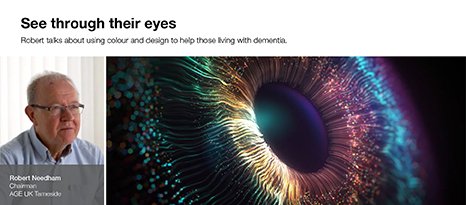In the third in our series of guest blogs about inclusive design for dementia, Robert Needham, Chair of Age UK Tameside, outlines the needs and responsibilities of a community centre that caters for people living with dementia.
The responsibility of a centre such as Age UK Tameside is great. Many of the people who use our centre are in their 70s and 80s and some have dementia, as well as other impairments such as poor eyesight. As Chair, it is my responsibility to ensure that the service we provide creates a dementia-friendly environment for these people.
Our centre was built in the 1970s, and like most buildings from that era, has required a number of adjustments over the years to best serve the needs of those who use it. The changes that we have implemented include ensuring that all steps are well-marked, that handrails are installed in the correct places, that all flooring we install is non-slip, and that all edges throughout the building are clearly marked.
All these measures are vital to ensuring the safety of our building users, and all relate to visual appearance and colour. This is an extremely important consideration when working with people who have dementia.
When an elderly person with dementia or poor eyesight enters a room, they must know exactly where they are going and how they can get there. Due to the difficulties many of these people experience with vision, this is no simple matter. The best solution that we have found is to use colour-coding.
Our approach to colour can be defined as blend and contrast. For example, areas where centre-users don’t go are white in our building, whereas areas they do use have yellow markings. Similarly, all our handrails are coloured appropriately so that they can be seen by all centre-users, while our floorcoverings are chosen for their low visual contrast so that users don’t trip over.
People with dementia are above all human beings who thrive when able to take part in meaningful activities. That’s why we have installed a lift in our building, allowing wheelchair-users to get around more easily – for example to take part in activities on the first floor. It’s also why our outdoor area is so important, allowing people to get outside and do activities in our garden, which has been specially designed so they can use it in a sequenced and orderly fashion.
The value of companies that understand these special requirements, as Gradus do, is huge. By creating products for dementia-friendly environments, they enable us to do our job. Not only this, but Gradus have the expert knowledge to advise us on specific installations within our building. Just as people with dementia need individual treatment, so does an organisation like ours.
Speak to us for expert advise about how to design for independant living and inclusive design, including dementia, on 01625 428 922



